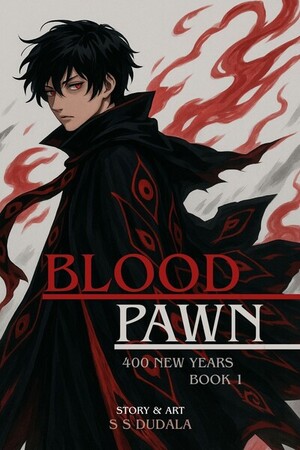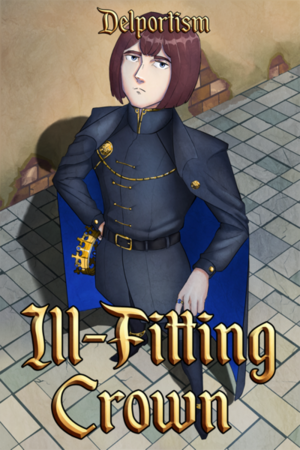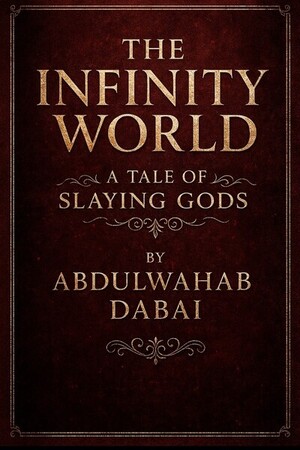Chapter 16:
Master of none
Blood Pawn : 400 New Years (Book 1)
As I descend the stairs, I feel it immediately—that subtle shift in the air, like the house itself is holding its breath. There’s a presence waiting for me at the bottom, and every creak of the wooden steps seems louder in the silence, as if someone’s been counting each step I take.
My eyes drift downward, and sure enough, leaning casually against the wall at the base of the staircase is a tall, broad-shouldered figure. His sword hangs loosely by his hip, and the light from the nearby window catches the edge of the blade, giving it a faint, cold gleam.
That familiar stance, all confidence and ease—it can only be Uncle Darius.
“What are you up to, Ori?” he asks, his voice a smooth blend of curiosity and amusement, like he already knows the answer but enjoys making me squirm. A slight grin tugs at the corner of his lips, just enough to remind me that he’s always one step ahead.
Before I can answer, Morgana appears behind me, her arms crossed as she steps into the hallway with a knowing look. “Reading again,” she says, her tone light but teasing. “Just like last time. Always buried in those books.”
I keep descending, each step slow and deliberate, trying to look as innocent as possible, though I can feel Darius’s eyes on me the whole way down.
He waits patiently, like a hunter sizing up his prey, and when I finally reach the last step, he moves fast—swooping me up effortlessly in his strong arms until I’m face-to-face with his rugged, scruffy smile.
“Reading’s good,” he says, his tone warm but carrying that hint of firmness that always makes it clear he’s not just making conversation.
“But you’ve got to play too, little man. Run around, roughhouse a bit. Build some muscle. Otherwise, how can you ever be as strong as me?”
To emphasize his point, he flexes his bicep, showing off the impressive curve of muscle beneath his tunic.
The scarred skin there speaks of battles fought and won, of years spent wielding the sword at his side. His arms are solid, unyielding, yet there’s a gentleness in the way he holds me, like he’s afraid he might accidentally break something fragile.
Darius grins, raising his eyebrows as if daring me to challenge him, and for a moment, I can’t help but be drawn in by his energy.
He’s every bit the warrior—strong, skilled, and battle-hardened. A former knight who’s seen countless battles but now wears the mantle of protector and leader here in the village. And yet, despite his rough exterior, he’s always shown a softer side around family, treating me less like a nephew and more like a son he’s training to follow in his footsteps.
“I bet you can’t even lift a sword yet, can you?” he teases, giving me a little shake that makes me laugh despite myself.
“How about we start with sticks, hmm? Maybe we can have a duel later, see if you can keep up.”
There’s a spark in his eyes—a mixture of pride and excitement, as though he can already picture me wielding a sword, standing tall at his side. It’s hard to resist that look, hard to ignore the way he speaks as if he can see my potential even when I can’t.
I feel my lips twitch into a reluctant smile. Darius has always had that effect on me, dragging me out of my head and into the present, even when my thoughts are still lingering on ancient legends and forgotten truths.
“Sure, Uncle,” I say, trying to sound as enthusiastic as he wants me to be, though part of me is still caught up in the pages of the book I left upstairs. “But… can I finish my book first?”
Morgana rolls her eyes with a playful sigh, her lips curling into a half-smile. “Of course you’d say that. You’re like a little old man trapped in a boy’s body, Orion.”
Darius chuckles, setting me down gently before ruffling my hair with that same rough affection he always shows. His fingers tousle the strands into a mess, but I don’t bother fixing it. That’s just Darius.
“Alright, alright, scholar. Finish your book. But after that, we’re heading outside. You need some fresh air, and maybe we can even convince Elara to join us. She could use the exercise too.”
I nod, relieved to have a bit more time before I’m dragged back into the lively chaos outside. As I walk past them, heading toward the staircase, I catch a glimpse of Morgana’s knowing smile. There’s something in the curve of her lips, a quiet understanding.
She’s glad Darius is trying to get me out more, sure—but there’s also something else there. It’s subtle, but I can feel it. Maybe she knows I’m searching for something in those books, something I haven’t told anyone yet.
“Just don’t lose yourself in those pages, Ori,” she says softly, her voice almost a whisper, as if she’s reading my thoughts. “There’s a whole world out here, waiting for you.”
I don’t respond. I just give her a small nod and continue climbing the stairs, each step creaking beneath my weight.
The noise and laughter from downstairs fade into the background as I retreat once more to my sanctuary, the quiet little corner at the top floor of Uncle Darius’s house.
This room, tucked away from the rest of the household, is where I can think. Where I can breathe. Where the outside world falls away, and all that’s left is me, the musty smell of old paper, and the faint golden light that filters in through the small window.
I settle back onto the cushion near the window, pulling the Adventurer’s Encyclopedia back onto my lap. As I flip through the pages, my thoughts drift back to something that’s been on my mind for weeks: mana. The lifeblood of magic and power in this realm.
In this world, mana isn’t something everyone can wield. It’s rare. A gift bestowed upon only about one in every hundred people.
Most children discover their potential around the age of 6-8 , when their bodies begin to react to the flow of mana in the air. Those who are gifted have to choose how they’ll harness it—and that choice shapes everything that comes after.
There are three primary techniques for wielding mana: Mana Core, Mana Heart, and Mana Circles. Each one is distinct, with its own strengths, weaknesses, and philosophies.
Mana Core
I trace my fingers along the illustrations on the page, my eyes narrowing as I study the diagrams of glowing orbs nestled within a warrior’s chest. The Mana Core technique is a favorite among fighters, beastkin, and anyone who relies on raw strength and physical prowess.
A Mana Core is exactly what it sounds like: a dense, concentrated reservoir of energy located deep within the user’s body, often near the solar plexus. It functions almost like a second heart, generating mana and storing it until the user calls upon it in battle.
The strength of a Mana Core is measured by its color, and the book explains the ranking system in detail:
White Core – The weakest and most common. A newly formed core that hasn’t yet been refined. Red, Orange, Yellow, Green, Blue, Indigo – Each color represents a stage of growth and refinement, with the core becoming denser and more potent as the user’s strength increases. Violet Core – Rare and powerful. Users with Violet Cores are said to possess enough mana to rival entire armies. Black Core – The rarest and most feared. A Black Core doesn’t just generate mana—it corrupts it, twisting it into something dark and destructive. Few survive long enough to develop a Black Core, and those who do are often hunted as threats to the realm.The book lists the pros and cons of the Mana Core technique in neat, bullet-pointed sections:
Pros:
High-Output Power: A Mana Core can release bursts of energy far beyond what most other techniques allow, making it perfect for intense, fast-paced combat. Endurance: Because the core generates mana continuously, users with strong cores can endure long battles without running out of energy. Even if they’re injured, their core will keep producing mana to keep them going.Cons:
Limited Supply: Users with Mana Cores can’t draw mana from their surroundings. They rely entirely on the mana stored in their core. If they overextend themselves and deplete that supply, they’re left vulnerable until their core has time to recharge. Overload Risk: If a user tries to draw more mana than their core can handle, it can crack—or worse, shatter—leading to catastrophic consequences. A shattered core is almost always fatal.Mana Heart
I flip the page, and my eyes land on the next diagram—a detailed sketch of a glowing heart, with tendrils of mana flowing through the veins like blood. The Mana Heart technique is more delicate and versatile than the brute-force approach of the Mana Core. It’s favored by swordsmen, hunters, and anyone who values agility, precision, and adaptability.
Unlike the Mana Core, which stores energy in a single, concentrated point, the Mana Heart technique involves pumping mana throughout the entire body. The user’s heart acts as a central hub, sending mana surging through their bloodstream with every beat. This creates a constant, gentle flow of energy that enhances the user’s reflexes, speed, and strength.
The book explains that this technique allows users to sense and interact with the mana in their surroundings, giving them a kind of sixth sense that’s invaluable in battle. They can use this ability to boost their physical abilities temporarily, adapt to their opponent’s movements, or even heal minor injuries by directing mana to damaged areas.
Pros:
Balance and Efficiency: The Mana Heart technique provides a steady, reliable source of power without the explosive bursts (and risks) of a Mana Core. Adaptability: Because users can sense and manipulate ambient mana, they can adjust their tactics on the fly, making them incredibly difficult to predict or pin down in combat.Cons:
The pages beneath my fingertips feel worn and fragile, as though they’ve carried the weight of centuries. I trace the faded lines of an old diagram, my brow furrowing in concentration. The sketch before me depicts glowing rings—
Mana Circles,intricately linked around the heart of a robed figure. The ink, though faded, pulses with the ancient knowledge scrawled across the parchment.
I shift slightly on the cushion near the window, the golden light of the late afternoon filtering through the cracked glass, casting dappled patterns across the floorboards.
Outside, I can hear the distant chatter of villagers, the occasional bark of a stray dog, and the rustling of leaves as the breeze dances through the trees. But here, in this quiet little corner, the only sound is the soft rustle of pages as I lose myself deeper in the text.
Mana Circles
They aren’t just theory—they’re the lifeblood of mages, scholars, and anyone who dares to delve into the arcane. Unlike the brute-force power of a Mana Core or the balanced efficiency of a Mana Heart, Mana Circles are about precision. Mastery. They’re for those who understand that true power lies not in strength alone, but in control.
The book describes how the technique works, and I read the words as though they’re being spoken directly into my mind.
Mana Circles form as ethereal rings around the heart, acting as conduits for manipulating and absorbing mana from the environment. The more circles a mage possesses, the greater their magical potential. Each circle enhances the flow of mana, allowing the user to cast more powerful spells and sustain them longer.
I lean closer, my breath fogging the corner of the page as I absorb the details. It’s a delicate balance—too many circles, and the flow becomes unstable, like trying to control a raging river with your bare hands. Too few, and the output remains weak, leaving the mage vulnerable.
The book breaks down the pros and cons, and I read them carefully, letting each word sink in:
Pros:
Environmental Absorption: Unlike those with Mana Cores, who rely solely on their internal reserves, mages with Mana Circles can draw mana from their surroundings. This allows them to weave complex spells, enchant objects, or even control elements.
Spell Versatility: The more circles a mage has, the more options they have in battle. They can adapt their spells on the spot, combining different elements to suit the situation—a wall of flame, a freezing mist, or even a protective barrier of light.
Mana Efficiency: Because they can absorb ambient mana, mages with Mana Circles rarely run out of energy, unless they push themselves beyond their limits.
Cons:
Mana Capacity Limits: While mages can absorb mana from their surroundings, the strength of their spells still depends on their own mana capacity. Manipulating high-level spells takes a significant toll on their reserves.
Overreach Risk: If a mage overextends themselves—channeling more mana than their circles can handle—they risk severe consequences. Overloading a circle can cause it to rupture, leading to magical backlash that could leave them drained, injured, or worse.
Training and Discipline Required: Maintaining even a single circle takes years of training and discipline. Most mages never make it past two or three circles. Those who possess six or seven are considered prodigies, and those with nine are practically legends.
I exhale slowly, my fingers brushing the edge of the page. This technique isn’t just about raw power—it’s about mastery. About pushing the limits of what’s possible without losing control.
The book goes on to explain how each technique shapes not just how people fight, but how they live.
Those with Mana Cores are the bruisers, the frontline warriors who can take a hit and keep going. Those with Mana Hearts are swift and deadly, cutting through the battlefield like a blade. And those with Mana Circles—they’re the thinkers. The strategists. The ones who can bend reality to their will, shaping the battlefield with nothing more than a thought.
My gaze lingers on the next section, where the book describes how mages discover their circles. The process is different for everyone, but it usually begins with meditation—focusing on the heartbeat, feeling the flow of mana, and visualizing the formation of the first ring. For most, that first circle takes years to form. For some, it never forms at all.
In my past life, I wasn’t just a typical mage. I let out a quiet breath, my chest tightening as the memories resurface.
Sure, I was classified as a three-circle mage, but that title never truly captured my abilities. Even the goddess-favored Yuui couldn’t stand against me.
I wasn’t bound by the limitations of a single technique; I’d pushed my body and soul beyond their natural limits, blending the strengths of all three major methods of mana control.
I close my eyes, the memories coming in flashes. The cold wind biting at my face as I stood atop the ruined citadel. The roar of the battlefield below. The crackling energy of the Mana Core within me, pulsing like a second heart. I was a jack-of-all-trades—and a master of none. But that didn’t matter. What mattered was that I had survived.
I had started by training my heart to become mana-sensitive, using the Mana Heart technique.
It allowed me to pump mana throughout my entire body, heightening my senses and making my physical attacks almost supernatural.
But I didn’t stop there. I had integrated Mana Circles around my heart, like ethereal rings orbiting a glowing star. This was the foundation of a mage’s power, giving me access to spells of immense potency and precision.
And then, I had achieved what no other mage dared to—integrating Mana Cores within those circles.
I can almost feel the burn of the mana, the searing heat that had coursed through me as I forced my body to adapt.
Imagine it: a solar system of cores orbiting my heart, each core functioning as its own mini-generator of energy, amplifying my output while maintaining a continuous flow of mana.
It was like having multiple suns blazing within me. The process had nearly killed me—twice. But I had endured.
Because of it, I could manipulate blood with unmatched precision, sense even the subtlest of threats, and fight relentlessly without tiring.
Now, in this life, I need to do it all over again. But this time, I can’t rely on the same tricks. Using blood magic would raise too many questions—who taught me, where did I learn such a forbidden skill? And there’s another complication…
I flip the page, and my eyes land on the next diagram -Dragons.
In my previous life, I had Valthryx, my loyal dragon. A beast of unparalleled strength and wisdom, Valthryx had handled the dragons for me—I never had to lift a finger. But now? I’ll have to face them myself, without the luxury of a draconic ally.
“Orion, come down!” Darius’s voice snaps me out of my thoughts, echoing through the house like a clap of thunder.
I let out a sigh, closing the book with a soft thud. This was going to be harder than I thought.
With no Valthryx and no blood magic, I would have to find another way to become the ultimate weapon again. But for now, there’s no escaping Uncle Darius’s summons.
“Knowledge is strength,” I remind myself, pushing to my feet. Whatever path I take, I need to be ready.




Please sign in to leave a comment.